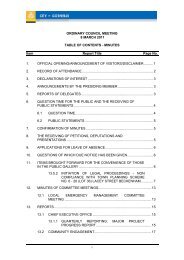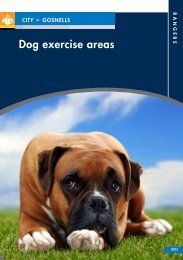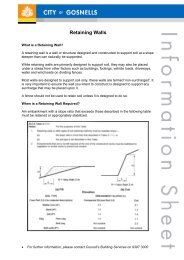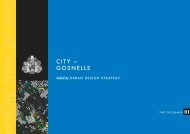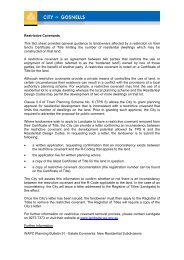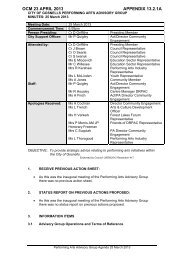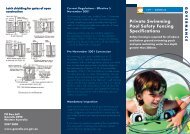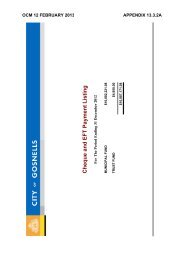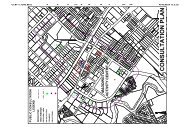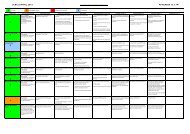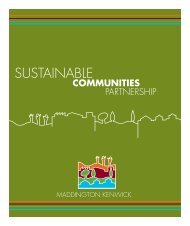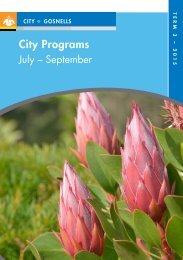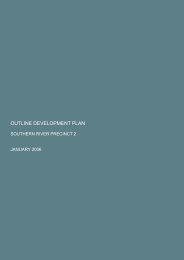Regional Setting 52. Regional Setting2.1 ClimateWeather records for the <strong>Gosnells</strong> <strong>City</strong> weather station taken over the past 17 years can be used to gain anunderstanding <strong>of</strong> the climate <strong>of</strong> the MKSEA (Table 2.1: adapted from Bureau <strong>of</strong> Meteorology, 2009). Themajor factors in the rainfall and wind patterns <strong>of</strong> the Maddington-Kenwick area are the eastwardly migrating,anti-cyclonic pressure cells that bring rain-bearing fronts over the region in a seasonal pattern (Gentilli,1972). In general, the climate in the MKSEA can be described as warm, subhumid and Mediterranean with apronounced annual drought for 4-5 months each year and cool, wet winters. Over the period 1961-2008, thetemperature at <strong>Gosnells</strong> <strong>City</strong> ranged from a mean daily minimum <strong>of</strong> 8.8°C in August to a mean dailymaximum <strong>of</strong> 32.7°C in January and February. The mean annual rainfall at <strong>Gosnells</strong> <strong>City</strong> over the sameperiod was 835.4 mm. On average, approximately 85% <strong>of</strong> the annual rainfall over this period fell betweenMay and October. In 2006, the year prior to the beginning <strong>of</strong> the current survey, the total rainfall recorded atthe <strong>Gosnells</strong> <strong>City</strong> weather station was only 553.1 mm, i.e. approximately 66% <strong>of</strong> the mean annual rainfall forthe period 1961-2008. Therefore, in spring 2007, when most <strong>of</strong> the current flora survey was conducted, theMKSEA was recovering from the worst drought the region has experienced since the beginning <strong>of</strong> detailedweather records 46 years ago.The annual rainfall in south-west Western Australia has shown a steady decline over the past three decades(Bureau <strong>of</strong> Meteorology, 2009). Further rainfall decline and rising temperatures are predicted for the regionin the future. These anticipated climatic changes are acknowledged as posing a serious threat to thebiodiversity <strong>of</strong> south-west Western Australia (Pittock, 2003).The continuation <strong>of</strong> the trend towards drier conditions in this region indicates that a much greatereffort and innovative solutions will be required in the future to manage dwindling water resources in amore sustainable manner in the MKSEA and the Greater Brixton Street Wetlands to supportbiodiversity and human activities.Table 2.1: Climatic Data from <strong>Gosnells</strong> <strong>City</strong> Weather Station (1991-2008)Temperature (°C) (1991-2008)Jan Feb Mar Apr May Jun Jul Aug Sep Oct Nov DecMean daily max 32.7 32.7 30.3 26.2 22.6 19.5 18.7 19.1 20.6 23.5 27.4 30.1Mean daily min 18.1 18.5 17.1 14.6 12.1 9.8 9.0 8.8 10.0 11.3 14.4 16.0Mean rainfall (mm) (1961-2008) compared to rainfall in 2006, 2007 & 2008Jan Feb Mar Apr May Jun Jul Aug Sep Oct Nov DecAnnualTotalMean rainfall (1961-2008) 11.9 16.2 15.4 45.4 106.9 177.9 164.6 129.2 80.8 48.2 27.8 10.7 837.7 46Rainfall in 2006 27.0 34.6 9.4 32.5 29.2 42.0 86.8 160.0 63.4 35.9 23.3 9.0 553.1 1Rainfall in 2007 18.3 17.7 11.6 79.3 89.6 90.4 192.1 126.4 109.1 59.8 3.7 18.8 816.8 1Rainfall in 2008 0 31.6 12.9 170.8 103.9 142.5 195 21.5 85.2 47.8 59.0 14.2 884.4 1(Bureau <strong>of</strong> Meteorology, 2009)Years2.2 LandformsThe MKSEA is located about 15 km south-east <strong>of</strong> the centre <strong>of</strong> the <strong>City</strong> <strong>of</strong> Perth on the eastern Swan CoastalPlain (ESCP) and about 3-4 km west <strong>of</strong> the Darling Plateau. The Swan Coastal Plain (SCP) comprises aseries <strong>of</strong> landform units <strong>of</strong> regional scale that are orientated more or less parallel to the coast (McArthur andBettenay, 1960). The regional scale landforms <strong>of</strong> the SCP that are represented in the MKSEA comprise theRidge Hill Shelf (Foothills), the Pinjarra Plain and the Bassendean Dunes (Figure 5).Tauss, C. and Weston, A.S. (2010). The flora, vegetation and wetlands <strong>of</strong> the Maddington-Kenwick Strategic Employment Area.A survey <strong>of</strong> the rural lands in the vicinity <strong>of</strong> the Greater Brixton Street Wetlands. Report to the <strong>City</strong> <strong>of</strong> <strong>Gosnells</strong>, W.A. Version 18.04.10
Regional Setting 6The Ridge Hill Shelf geomorphic unit (the Forrestfield mapping unit <strong>of</strong> Churchward and McArthur, 1980) isa more or less continuous ramp <strong>of</strong> about 1-3 km in width that lies immediately to the west <strong>of</strong> the scarp <strong>of</strong> theDarling Plateau. It includes Quaternary-aged sand, clay, conglomerate and laterite <strong>of</strong> the Yoganup Formationwhich, in the Perth area, correlates with the Forrestfield soil association (Biggs and Wilde, 1980;Churchward and McArthur, 1980).The Ridge Hill Shelf is dissected by many channel wetlands (including Yule Brook, Woodlupine Brook andBickley Brook in the vicinity <strong>of</strong> the MKSEA and the main channel <strong>of</strong> the Canning River, south <strong>of</strong> theMKSEA). These streams have their headwaters on the Darling Plateau and flow west towards the SCP. Thesmaller streams terminate within the Ridge Hill Shelf, the Pinjarra Plain or the Bassendean Dunes, whilst thelarger streams (such as Yule Brook) discharge further west into the Swan-Canning Rivers system (PerthGroundwater Atlas, 2004).The Pinjarra Plain geomorphic unit adjoins the western margin <strong>of</strong> the Ridge Hill Shelf and forms a flat togently undulating landscape. This unit comprises Quaternary age sediments <strong>of</strong> the Guildford Formation(Churchward and McArthur, 1980) that originated on the Darling Plateau and were deposited on the ESCP asalluvial fans. The Guildford Formation includes layers <strong>of</strong> gravels, sands, muds and clays in sequences thathave been complicated by aeolian reworking and by channel migration. Other sediments materials that wereformed in situ by precipitation (such as ferricrete and, less commonly, Muchea Limestone) are also presentwithin the Pinjarra Plain. The Greater Brixton Street Wetlands and the MKSEA are part <strong>of</strong> a Pinjarra Plainalluvial fan complex that was formed over many thousands <strong>of</strong> years in association with watercourses (thatare now represented by Yule Brook and Bickley Brook) draining from the Darling Range. The Kenwick –Wattle Grove alluvial fan complex has been shown to include a varied array <strong>of</strong> stratigraphic sequences andhydrological patterns that is correlated with a rich mosaic <strong>of</strong> fine-scale vegetation assemblages (V & CSemeniuk Research Group, 2001). This very high habitat heterogeneity is, undoubtedly, a major factorunderpinning the high biodiversity <strong>of</strong> the area.The Bassendean Dunes geomorphic unit is an undulating plain <strong>of</strong> low-relief dunes composed <strong>of</strong> BassendeanSands (Churchward and McArthur, 1980). The Bassendean Dunes generally comprise well-drained, deep,aeolian, quartz sands with few drainage channels. However, basins filled with shallow peat, peaty sand orhumic sand are <strong>of</strong>ten present between the dunes, and these may be seasonally inundated or seasonallywaterlogged, most commonly due to the surface expression <strong>of</strong> the regional watertable (Semeniuk, 1987;Semeniuk and Semeniuk, 2004). The Bassendean Dunes setting is stratigraphically simple compared to thePinjarra Plain. Although the Bassendean Dunes provide a range <strong>of</strong> plant habitats (Semeniuk and Glassford,1989), these habitats are much less varied and more similar to habitats <strong>of</strong> the other coastal dune systems <strong>of</strong>the SCP rather than those <strong>of</strong> the Pinjarra Plain.There is a transitional zone (the Southern River geomorphic unit) between the Bassendean Dunes and thePinjarra Plain where Bassendean Sands encroach over the clays <strong>of</strong> the Guildford Formation. In the SouthernRiver unit, dunes alternate with low lying wetlands. The Southern River wetlands differ from the main suite<strong>of</strong> wetlands found in the Bassendean Dunes in that they are, in general, formed by water perched by the claysoils <strong>of</strong> the underlying Guildford Formation (Hill et al, 1996). In the southeast <strong>of</strong> the MKSEA, the PinjarraPlain surface is overridden by Bassendean Sands which are outliers from the larger area <strong>of</strong> BassendeanDunes that is located south <strong>of</strong> the Canning River. The Bassendean Sands in this area <strong>of</strong> the MKSEA havepiled up as low dunes against the colluvial sands <strong>of</strong> the Ridge Hill Shelf that abut the eastern boundary <strong>of</strong> theMKSEA near the Clifford Street Bushland (BFS 53).2.3 Superficial Sediments (Soils)Most <strong>of</strong> the MKSEA was mapped by Jordan (1986), at a scale <strong>of</strong> 1:50,000, as shallow Bassendean Sandsover the sandy clay <strong>of</strong> the Guildford Formation (S10) (Table 2.2; Figures 6, 11). Although Figure 6 is at ascale that is too broad to assist in the interpretation <strong>of</strong> wetlands or fine-scale vegetation assemblages it isuseful in illustrating the location and extent <strong>of</strong> some <strong>of</strong> the general landforms in the area. The natural course<strong>of</strong> Yule Brook is evident in this mapping as sandy silt (Ms4). The extensive palusplain that extends belowabout 11 m AHD southwest <strong>of</strong> Edward St, Grove Rd and Brook Rd in Precinct 3A <strong>of</strong> the MKSEA wasTauss, C. and Weston, A.S. (2010). The flora, vegetation and wetlands <strong>of</strong> the Maddington-Kenwick Strategic Employment Area.A survey <strong>of</strong> the rural lands in the vicinity <strong>of</strong> the Greater Brixton Street Wetlands. Report to the <strong>City</strong> <strong>of</strong> <strong>Gosnells</strong>, W.A. Version 18.04.10



